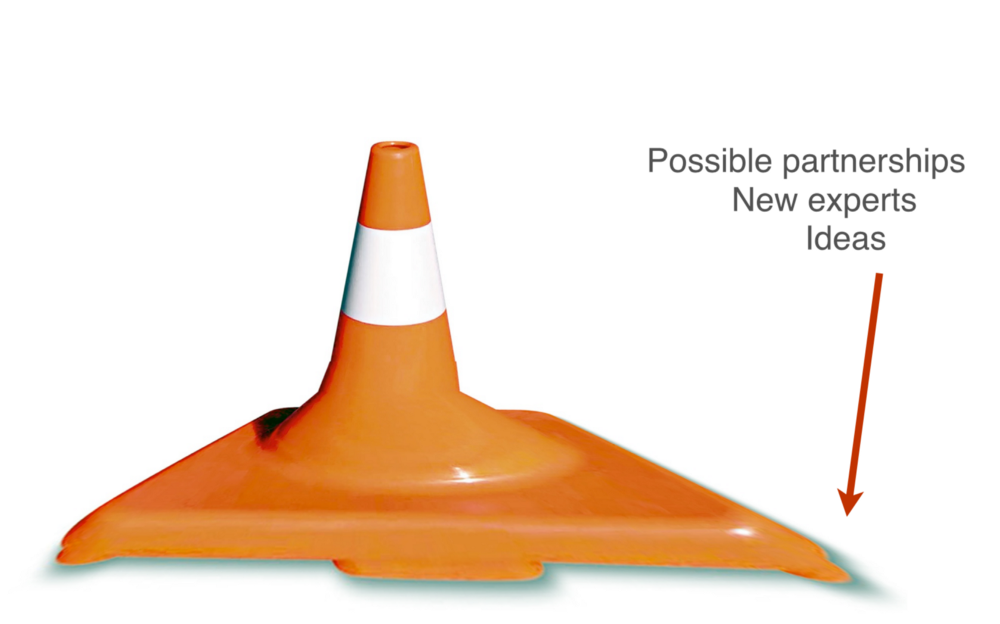
30 Jun Nobody really wants creativity, and that is a problem
Our culture mythologises creativity while, simultaneously, putting up barriers which prevent people from reaching their creative potential. Now is the time when business urgently needs a new conversation with the arts – a conversation centered not on sponsorship or ownership but on partnership.
I submit that without such a partnership, without accessing artists’ and creatives’ brains and not just their output, business leaders will from now on keep going around in ever decreasing self-referrential circles, in the misguided conviction that they are actively innovating. The need for new ideas is pressing, and business has to look for those further afield than the next “brainstorming offsite.”
Artists and creatives can, and should, be the sources of “the creative juice” required to shift our companies and our economies into World 2.0, if that world is to be anything like a place worth living in. How? Engage artists and creatives not just to do stuff but also to show you, teach you, how they think so as to get that stuff done. Yes, that means getting them into your boardroom, paying them a decent fee, listening to what they have to say and then giving it serious consideration. (I will get into the mechanics of how this ought to work in another article.)
You see, people readily applaud the achievements of star artists, musicians, designers and architects but that is usually the limit of their understanding of creativity, and appreciation of it. The great writer James Baldwin put it most succinctly, describing artists as “a breed of men and women historically despised while living and acclaimed when safely dead.”
The process is reduced to admiration of talent, and awards for spectacular success. There is an assumed barrier between “those people” and you. Creativity is for the chosen few. With talent, and special abilities. It’s just not a thing for average people. Right? Wrong. But you do need to learn how to shift your thinking into a more expansive, curious, searching mode, because creativity is a process, not a talent. It is a way of working and looking at things. Is consists of endless polishing of your craft, and not waiting for the Muses to Grace you with Inspiration. And lots of spade work, actually committing to getting good at functioning creatively. The painter and photographer Chuck Close summed this up: “inspiration is for amateurs. The rest of us just show up and get to work.”
In business, which urgently needs new thinking, most companies still do the thing they have always done, in the way they have always done it. Even now, in our weird new reality, they hope to get back to “normal” as soon as possible. Even if “innovation” has been put on a pedestal, enshrined in corporate vision statements and funded by private, state and transnational investors, most companies sing praises to innovation while hanging on to the coattails of the status quo. For good psychological reasons, of course — fear of failure, various biases — but also because most people, most of the time, do not really understand the direct connection between imagination, creativity and business innovation. We celebrate creativity and applaud the achievements of those star artists, designers and entrepreneurs, but when it comes down to it we accept the new and exciting only once it has been well tested by others.
“Education systems” everywhere have done an excellent job of beating all but the safest and blandest ‘creativity” out of pupils. That’s where the stupid, destructive conviction that creativity=being able to draw comes from. Worse, that is also where understanding of creativity also ends for most people. “Accepted creativity” is limited by fear. Which is rather unfortunate, because actual creativity comes from courage. If you arere able to draw a perfect apple, that does not make you creative, merely skilled at drawing apples. If you’re able to draw an apple that says “fuckya” to the established way of drawing apples, that is what drives creative progress. It comes from a place of curiosity and a desire to find out “what happens, if…?” Curiosity opens the door to creativity and creativity drives engagement, commitment and, of course, real innovation.
Right now is when we have needed extreme innovative thinking the most. There is no going back to normal. Perish that pathetic excuse of a thought. Given how crucial new ideas are to our ability to build World 2.0 — and how important it is that those ideas be drawn rom the widest possible pool of personal perspectives and cultural insights, we need to consciously work to remove that barrier between creativity and “normal people”, and broaden the definition of what we see as creativity in the first place. We need to get into the real work of true innovation thinking, across industries and verticals, with all the hard work and complications this entails.
Can you remember the last time when you spent a week working on something completely new, doing things in ways which were different from the usual ways of doing things, connecting with people outside of your normal circle of colleagues? Because if you haven’t, you weren’t actualy doing innovation.
Don’t feel bad. You are not alone in this. Science tells us, this is a universal problem. There is a ton of research which confirms what we all know deep down: everyone wants innovation, but only after someone else has taken the risk and the trouble to make sure it works first. We want innovation, but not the possibility of having to try a number of times before we get anything decent.
What often ends up happening is a sort of a complicated innovation theatre — which may look interesting, but does not get us any closer to actual innovation taking place.
Case in point: a couple of years ago, after twelve months of correspondence aiming to arrange a time to meet, I finally made a presentation to many of the decision makers of a large, well-known construction company. They wanted to look at ways they could become more, you know, innovative. “Too many of them in this room” I though, but proceeded to give my talk which was, ostensibly, well received. Head nodded, lips smiled. Another month went by, then another… I was eventually told that they were “not going to pursue innovation this year.” An interesting statement, I thought, since it opened up a whole raft of possibilities when trying to deconstruct its full significance.

So where to start? Allow me to draw a three-dimensional map of your business. Actually, it is a map of every business, and it resembles a severely squashed down traffic cone.
The peak, the highest area right in the centre is where you are busy building up a pile of knowledge, expertise, maybe even success and wealth. It is where the most brain power of your organisation is focused.
Around it is the “slope of progressive execution” — where methods are worked out, products tested, procedures developed so as to keep building up that central peak. It covers a lot of ground and is the supporting piece of landscape as far as the peak is concerned. Out towards the edges, where the circumference of the squashed cone is the largest, that is where your organisation interfaces with other pieces of the landscape — other companies, the world at large — that area which you might describe as “not us.”
Around that circumference is where new ideas are formed. You become progressively more familiar with those ideas as they move towards the centre, but at the edges, where your ideas clash against the ideas of others, that is where the “necessary new” comes into being. You may capture the new and carry it towards the centre in time, but to begin with you are out along the boundary line, where new ideas hatch, listening hard to discover which ones might be interesting, and placing your bets accordingly. This process needs to be supported. If possible, it needs to be formalised, given a framework to hang on and, yes, you can learn different ways of accessing all that “new goodness” from artists and creatives. (More on that coming up in another article, promise.)
Creativity is in part about connecting what is in our heads with ideas from “the edge” and seeing patterns and linkages which may not be apparent to anybody else at the time. Which results in innovation. To get more creativity, you need to extend the size of this flattened out area, and speed up the rate at which ideas from the edge get carried towards the centre, up that slope of progressive execution. That is where those conversations and partnerships with artists and creatives really bear fruit. You are aiming at a space where innovating is as much a natural part of your business operations as planning and execution.
To innovate, we need to imagine, as imagination means not sticking to what we know. To imagine means to let go of boundaries, and to face the fear of the unknown. To do that properly, you need teachers and role models. Role models of imagination.
Imagination is perhaps not a concept which immediately springs to mind when we are asked to list strategic values but I would argue that it actually ought to be at the very top of that list today. A severe lack of imagination has got us into many of the tight spots in which we find ourselves today.
Executives need to find ways to strengthen their own imagination, and grow the imaginative faculties in their people. And to learn about imagination in a time of change, you need to go to the only class of people who see change as fuel and imagination as the daily practice of their craft. Over time, creative professionals have been defined as providers of specified services (writing, photography, music, visual art) which are sometimes seen as somewhat opaque and magical. Apparently, we reach for starlight and mix it with mud and breath of unicorns, to make something the World has not seen before. Which is a lovely image, though not quite an accurate one.
What we do is think differently, and we do it as a matter of course. Because of this we are able to handle change better than many other people, and to work with this change as raw material, and as fuel for creating.
Creative professionals can answer the call when someone asks “take me, where I haven’t been.”
In this little request to look just beyond that boundary line where art and commerce ordinarily meet, lies very real value to the business world. Business people do not usually venture there, but now really, urgently, must.

The mental processes artists and creatives employ can help in the context of looking for ways to tap creative potential, and creating conditions conducive to innovation thinking. Where most business thinking centres around delivery of optimised, repeatable result, creative professionals eat and breathe change, variety and exploration. To imagine situations, run scenarios and quickly assess options is entirely familiar territory to the majority of creative professionals, regardless of their specialisation. This is not necessarily because every creative professional is a natural born genius. Many are, but most are professionals who have focused on making this kind of thinking into daily practice.
The mutual exchange of value between business and creative professionals can, therefore, take place on planes other than just what we have been used to. The value which creative professionals can bring to the table, in addition to providing their specialised services, is in assisting executives in being able to look into the future and to train their people to work in this quickened, confusing, rapidly changing digitally transformed context that surrounds us.


